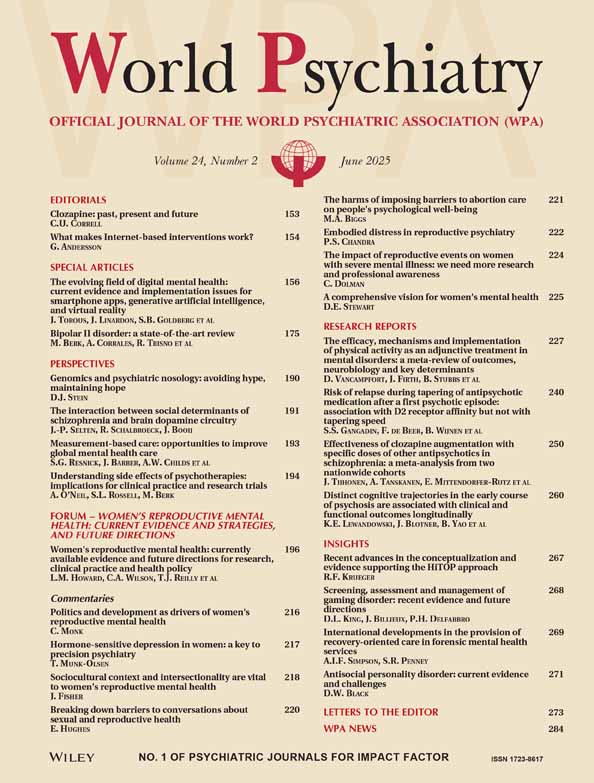Further thoughts on the relation of personality and psychopathology
In his usual incisive and erudite way, T. Widiger has outlined the manner in which personality and psychopathology may relate conceptually. I wish to make two points in this brief commentary. First, others have approached this important matter by setting forth a number of alternative personality/psychopathology hypotheses; I will note several of these briefly in order for the reader to be further enlightened as to how other scholars and investigators approach the subject. Second, and in response to Widiger's “factorial orientation”, I will touch on a number of concerns regarding the use of statistics in building the foundations of personality/psychopathology classification.
Eight alternate hypotheses regarding the personality/psychopathology relationship are herein noted 1:
A. Characterological predisposition hypothesis. The most popular approach in both theory and research, the dispositional hypothesis, suggests that characterological personality disorders are primary, with psychopathology being a secondary outgrowth.
B. Complication hypothesis. In contrast to the characterological predisposition hypothesis, the complication thesis postulates that it is the experience of psychopathology that influences personality, not the other way around.
C. Attenuation hypothesis. Also known as the abnormal approach 2, this hypothesis presumes that personality disorders are an attenuated or alternative expression of the disease process that underlies the psychopathology.
D. Coeffect hypothesis. This hypothesis states that psychopathology and personality occur together as a result of a common third variable (e.g., traumatic childhood), even though they do not share a common psychobiological origin. In this sense, neither personality disorder nor psychopathology gives rise to the other.
E. Modification hypothesis. This hypothesis puts considerations of etiology and pathogenesis aside, proposing merely that personality features will substantially influence not only the manner in which psychopathology is presented clinically, but also responsivity to treatment and the prognosis of the psychopathologic episode.
F. The orthogonal hypothesis. This hypothesis suggests that whereas personality disorders and psychopathology are fundamentally independent entities, they frequently co-occur because both are, in effect, common conditions.
G. Overlapping symptomatology hypoth- esis. According to this hypothesis, the observed comorbidity of personality disorders and psychopathology is largely artifactual in that it results from overlapping criteria sets employed to diagnose each of the disorders.
H. Heterogeneity hypothesis. This final hypothesis postulates that several different sources contribute to the signs and symptoms of psychopathology and personality disorders. Various configurations of genetic/constitutional factors, in conjunction with environmental variables, may combine to produce differing vulnerabilities. A heterogeneous population arises from these various combinations, including a subset of individuals who evidence both the symptoms of psychopathology and personality disorder.
Concerns regarding Widiger's preference for employing the mathematical technique of factor analysis has been expressed for years in numerous quarters: empirical, philosophical and psychiatric 3,4.
Ever since the eminent physicist P. Dirac stumbled upon a mathematical device that uncovered the existence of a previously unobserved “anti-world” particle, there has been a recurring theme in the physical sciences favoring the power of math to reveal “realities” previously unimagined. Unfortunately, with the exception of a few recondite phenomena (e.g., Hawking's deduction of black hole radiation), the power of math as a decoder of unobserved realities in the life sciences has often been judged simplistic, irrelevant or invalid 5.
The state of statistical construction procedures in psychiatry has been summarized as follows: “Clinicians have at best given only a lukewarm reception to such classifications. They have been skeptical about the value of clustering methods to identify ‘naturally’ occurring subgroups. Furthermore, the classifications generated by these methods have not seemed particularly meaningful or relevant to everyday clinical practice” 6.
Kendell's 7 comment of some three decades ago, is, rather sadly, no less apt today than it was then: “Looking back on the various studies published in the last twenty years it is clear that many investigators, clinicians and statisticians, have had a naive, almost Baconian, attitude to the statistical techniques they were employing, putting in all the data at their disposal on the assumption that the computer would sort out the relevant from the irrelevant and expose the underlying principles and regularities”.
Among the striking data found in recent biological investigations is the awesome intricacy of standard statistical procedures, which were expected to produce evidence leading to construct coherence. Thus, it has been recently reported 8,9,10 that statistical analyses of our major genetically-based common diseases have proven much more complicated than initially expected. In diseases such as diabetes, cancer, and schizophrenia, the few sources that were detected statistically turned out to explain surprisingly little about their genetic origins. These common clinical syndromes prove to be associated with numerous and differing sets of genetic variants in each person. Mathematicians have concluded that complex genetic networks possess numerous intricate feedback loops. Some gravitate toward a stable balance and then stay there. Others home in on a repetitive cycle and then follow a circular pattern endlessly. Tweaked just a bit, the genetic architecture often crosses over into chaotic behavior, meandering through interactive sequences that are unpredictable and incoherent.
Hempel 5, the philosopher of science, has stated that mature sciences progress initially from statistically-based categories to others characterized by abstract concepts and theoretical relationships. The characteristic that distinguishes a scientific classification is its success in grouping its elements according to theoretically consonant explanatory propositions. These propositions are formed when certain attributes have been shown or have been hypothesized to be logically or causally related to other attributes (e.g., the personality/psychopathology relationship). The taxa that undergird a scientific nosology are not statistically-derived collections of overtly similar attributes (e.g., factorial categories), but a linked or unified pattern of known or presumed relations among them. A theoretically grounded pattern of relationships, such as those based on evolutionary principles, for example, do provide the foundation of a true scientific taxonomy.




